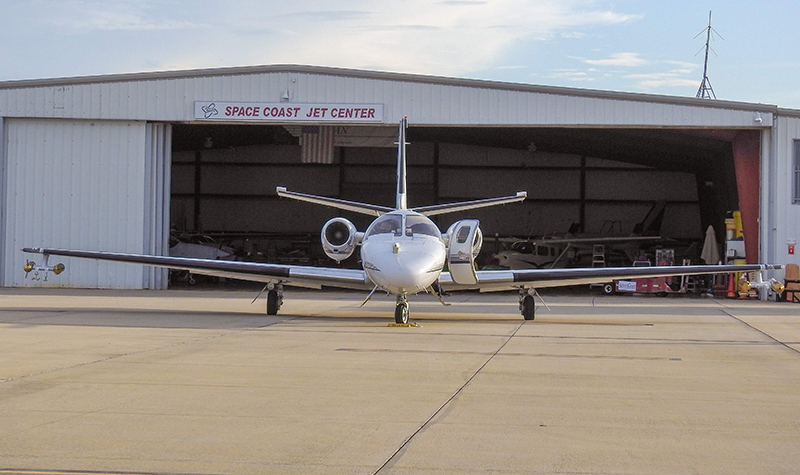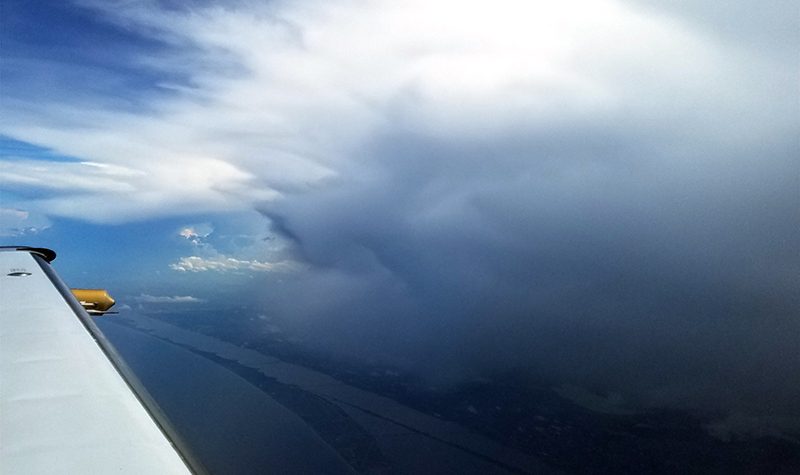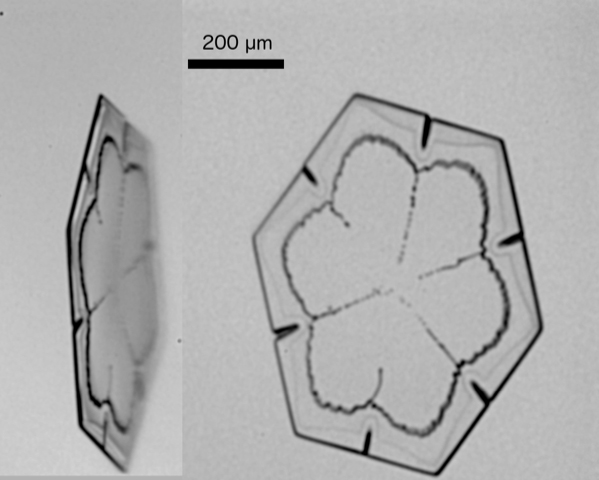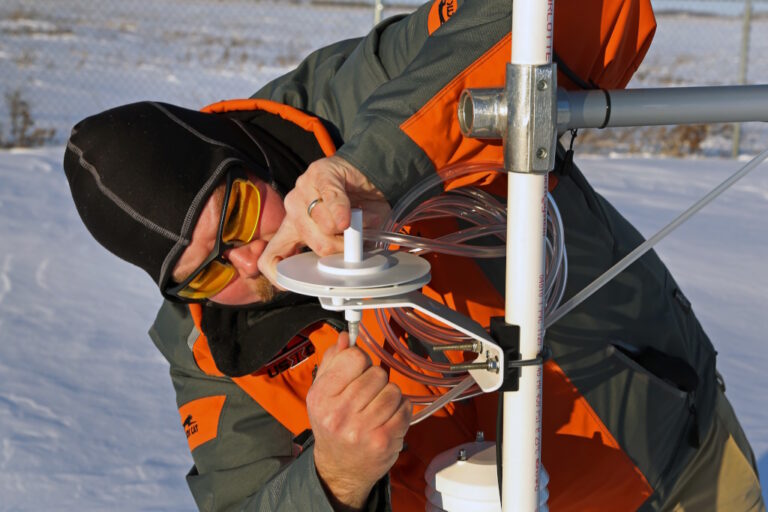Grads take flight for weather research
UND researchers gain valuable field experience collecting data in the heart of Florida’s coastal storms

Boarding a specialized Cessna Citation II Research Aircraft, UND researchers flew in proximity of coastal thunderstorms collecting atmospheric data this summer. The research was conducted on behalf of the U.S. Navy and in partnership with Weather Modification International. Image courtesy of Harrison Rademacher.
With its digital readouts, computerized storm-track maps and long hours spent interpreting forecast models, weather research could be compared to any number of sedate activities.
But to boxing?
Absolutely, suggests Shawn Wagner, a UND graduate student in atmospheric sciences from Bottineau, N.D. Talking about his fieldwork, Wagner consistently referred to “rolling with the punches,” especially when he spoke about this year’s Cape Canaveral Experiment — aka CapeEx19.
“Everyone has a plan until they’re getting punched in the face,” Wagner laughed, evoking the unconventional wisdom of fighting icon Mike Tyson. “You’re constantly busy, things are constantly changing. You just roll with it.”
Though not literally fending off strikes in the ring, Wagner and fellow UND graduate researcher in atmospheric sciences Kendra Sand did touch gloves with an unstoppable force this summer: Floridian thunderstorms.

David Delene
For two weeks in August, UND atmospheric sciences professor David Delene led a team of grad students and scientists to altitudes reaching 40,000 feet above Florida’s shores. Equipped with more than a dozen cutting-edge probes, a highly-specialized Cessna Citation II Research Aircraft flew a combined 26 hours above and around coastal storms, collecting data.
The effort was part of a million-dollar contract from the Naval Surface Warfare Center, and builds upon the work of two similar CapeEx projects from 2010 and 2015. All have had Delene as the principal investigator. For the experiment, UND subcontracted Fargo, N.D.-based Weather Modification International (WMI) to provide the aircraft and flight support necessary for high-level data collection.
Fitted out with the most advanced weather-measuring instruments available, the Citation II did work that could also be tracked by the Navy’s world-class radar system. Overall, the comparisons of on-scene and remotely gathered data will create better weather models for the Navy and help scientists such as Delene understand more about storm behavior and high-altitude clouds.
“It’s important to have graduate students involved in these measurements, to get people in the field,” Delene said. “So much of this science depends on proper measurements and being observationally driven. Good scientists are the ones who can not only understand the theories, but also perform the measurements — and the same thing goes for students.”
Being involved in field work is also a peak experience for students such as Wagner and Sand. Delene says the most important thing is the learning that happens – and given their training and experience in atmospheric sciences, Wagner and Sand were the perfect pupils for the tasks at hand.

While flying to heights reaching 40,000 feet, Sand was able to make observations through the windows while simultaneously monitoring the array of probes bringing in visual and numerical atmospheric data. Image courtesy of Kendra Sand.
Best seat on the plane
Coming to UND after earning her undergraduate degree from Embry-Riddle Aeronautical University, in January, Sand is pursuing her master’s degree. Delene recruited her as a means of getting her feet wet, ahead of her involvement in a larger venture measuring snow storms along the Atlantic Coast.
With a passion for both weather and flight (and, she noted, real-world boxing experience), Sand found herself in the right place to be one of Delene’s “flight engineers” for CapeEx19.
“It was a huge learning curve, but I feel a lot more prepared for my bigger projects,” Sand said.
As a passenger aboard all 12 flights of the experiment, Sand was charged with monitoring the computer system pulling in data from nearly every probe – most of which were situated as payloads underneath the wings of the jet aircraft.
As the aircraft flew to and from its mission of intercepting towering thunderheads, Sand would make observations from what she called the “best seat on the plane.”
“There were five seats on the aircraft, on one side; then the whole other side was a rack of instrumentation and computers,” she described. “I was in the back and had the most windows, so I would be making visual observations along with altitudes, temperatures and pressures.”
Besides looking out the window to observe, Sand watched a monitor displaying super-detailed images of cloud particles. That data would be flowing from the Particle Habit Imaging and Polar Scattering Probe, which would capture ice crystals — called “plates” — as well as larger particles forming during storm activity, called “plate aggregates.”
Observing these particles and their behavior during thunderstorms was one focus of the project for UND’s researchers.
Novel evidence
Wagner, who’s using a PHIPS probe in his own research for his master’s thesis, said the datasets collected during CapeEx are basic facts about the surrounding air. What makes the research novel is a combination of being “on the scene” of the storm-in-progress, as well as having precise, visual evidence to accompany numerical observations.
“We’re able to look at all of this data simultaneously,” Wagner said. “It’s one thing to have the number of particles, and concentrations of vapor associated with particles, but that only goes so far.”
With the PHIPS Probe’s stereographic imagery, drops and plates are observable in “perfect detail,” on the micron scale at which they exist.
“While on site, the team learned that the Navy already was altering its weather models, based on the team’s images from the PHIPS,” Wagner added. Beyond immediate implications for the Navy, the two weeks of data collection will supply years’ worth of analytical inquiry across a variety of atmospheric topics, Wagner said.

This is an image from the PHIPS of a pristine plate ice crystal. The probe takes two photos from opposing sides to develop a three-dimensional view of particles like this one. The scale presented in the image is 200 microns (a human hair is approximately 75 microns across). Image courtesy of Shawn Wagner.
Right path
Rolling with the metaphorical punches became a role of its own on the project, as communication equipment failures made Wagner the go-to messenger between the flight team and the off-site radar team. The latter provided up-to-the-second forecasts that were crucial to successful collection flights.
“Even if we weren’t in the air, it was constant contact between me and their person,” Wagner said. “They’d let us know everything happening, what they were seeing and what they were doing to get ready.”
So while he didn’t get in the ring as much as he thought he would, Wagner found more than enough excitement being the coach at the corner, working through issues technical and logistical. For examples, he worked with air traffic controllers, who are accustomed to directing flights away from sea-born storms; troubleshot and cleaned sensitive probes; planned flights; and maintained a crowded schedule, with flights occurring sometimes twice a day.
Being put in those positions was invaluable for Wagner, who’s pursuing his Ph.D. in atmospheric sciences at UND.
“It’s pressure and tension that’s continual over two weeks,” he said. “Some people aren’t cut out for that, but when you go through it and find that you not only don’t mind it, but it’s entertaining – it’s further encouragement that you’re on the right path.”

